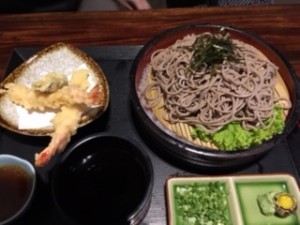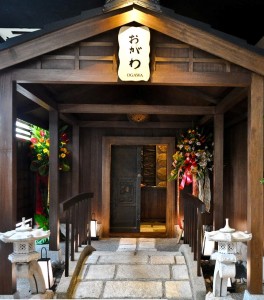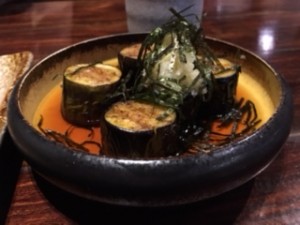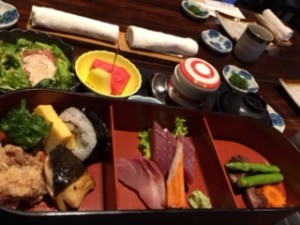 “I wouldn’t exactly call it ‘cooking’ but I can make noodles. That means I can boil water, put the pasta in and wait until it’s done.” ~ Devon Werkheiser, American actor.
“I wouldn’t exactly call it ‘cooking’ but I can make noodles. That means I can boil water, put the pasta in and wait until it’s done.” ~ Devon Werkheiser, American actor.
It is two years to the day since I posted a piece about my first trip to Japan, so it seems fitting that I should be writing this week about a Japanese restaurant here in Manila. Ogawa , an authentic, traditional Japanese restaurant, is located at the Fort Strip, on the corner of 5th and 28th that opened almost a year ago to the day. The downstairs entrance to Ogawa is not terribly prepossessing, but make the effort to climb the stairs, and you will be greeted by a smiling hostess in Japanese kimono, and a very cute entrance: stepping stones leading over a small arched bridge to an antique wooden front door. (Serious tip, don’t wear high heels, or if you do, walk around the bridge, not over it.) Once you have navigated the stepping stones, the bridge and the flapping curtains at the inner entrance, don’t be startled by the loud welcome of every waiter in the vicinity, as I was on my first visit. Distracted by the roar, I tripped inelegantly up the steps before lurching awkwardly through the curtains and into the middle of the dining room.
Thus announcing my arrival to the entire restaurant with less-than-impressive aplomb, I didn’t take in the décor that first time as, head down, I made a surreptitious dash to the booth on the back wall. On my next visit, I arrived early, prepared for the effusive greeting with a calm smile, and armed with my notebook.
Less flustered this time, I was able to take in the open kitchen, the wall of sake barrels, and the amazing wallpaper  depicting branches, birds and pine trees. Seated comfortably in ‘our’ booth, I scanned through the menu, jotting down every name I didn’t understand. I decided long ago that a menu is a great way to start learning a new language, as somehow the words for food, especially when you are hungry, stick better to your brain than incomprehensible verb conjugations.
depicting branches, birds and pine trees. Seated comfortably in ‘our’ booth, I scanned through the menu, jotting down every name I didn’t understand. I decided long ago that a menu is a great way to start learning a new language, as somehow the words for food, especially when you are hungry, stick better to your brain than incomprehensible verb conjugations.
While in Japan, I focused rather heavily on sushi and sashimi, but as one of the national staples, I felt I should also be fluent in the various types of Japanese noodle. With my glasses perched on my nose, and my trusty list, I quizzed Sachiko remorselessly, eager to see if she could explain the differences.
We talked noodles extensively, but also ‘chirasi’ and jyu jyu beef. The Chirasi Box was another menu mystery to me. Chirasi, Sachiko explained, means ‘scattered,’ and the dish consists of a bowl of rice topped with pieces of vegetables and fish: what basically translates as a bowl of ‘scattered’ or deconstructed sushi. The name jyu jyu, which made my friend giggle, apparently comes from the sound the beef makes in a sizzling hot cast iron dish .
Eventually I had sufficient, if somewhat convoluted notes and we could actually concentrate on ordering lunch. I have to say, though, that while the quote I found (see top of page) makes it sound easy, our discussion left me feeling I had a lot to learn about the art of cooking noodles.
In summary – and for my own reference as I am guessing you are probably fluent in Japanese noodles – ramen are made from similar ingredients to pasta (wheat flour and eggs) and compare to angel hair pasta but with a certain wiggle. Some further research led to the discovery that Ramen is a noodle soup that originated in China but has been adopted by Japan. Ramen can be served with a variety of toppings, each associated with a particular region.
 Soba are buckwheat noodles that look just like wholemeal pasta, and are about the circumference of your average spaghetti. A bowl of soba noodles can be served hot in noodle soup or cold with dipping sauce. Soba is popular all over Japan, and – just like pasta – can be bought fresh or dried. Soba noodles have terrific nutritional qualities too: high in proteins, minerals, dietary fibre, and micro-nutrients that aid liver function, blood pressure and cardiovascular health. As a bonus, they are low in fat and high in complex carbohydrates.
Soba are buckwheat noodles that look just like wholemeal pasta, and are about the circumference of your average spaghetti. A bowl of soba noodles can be served hot in noodle soup or cold with dipping sauce. Soba is popular all over Japan, and – just like pasta – can be bought fresh or dried. Soba noodles have terrific nutritional qualities too: high in proteins, minerals, dietary fibre, and micro-nutrients that aid liver function, blood pressure and cardiovascular health. As a bonus, they are low in fat and high in complex carbohydrates.
Udon noodles are the thickest of the trio, and made from white wheat flour, like ramen. Apparently simplicity is the key word for udon noodles, as they are generally served in a broth with a sprinkling of sliced onions. Or perhaps topped with tempura or tofu. Again, each region has its own take on toppings and serving suggestions, but it can also be served as a soup or a curry, making it particularly popular in winter, perfect for cold weather and illness.
The final word goes to Yakisoba. These noodles are made of buckwheat, and also originated in China, but has become popular throughout Japan. These are curly, like ramen However, they are never served in soup, but grilled or fried mixed with meat and vegetables, and garnished with red ginger. This noodle is particularly popular at Japanese festivals.
Despite all this chat about noodles, I left my friend to order a bowl of soba with its soy based dipping sauce, a tiny raw quail’s egg and a dish of scallions to accessorize. Meanwhile, I chose a Bento Box – of which there were several – which has long been a favourite with my One & Only. This beautifully arranged assortment of popular, bite-sized snacks is like a mini picnic basket or an antipasti platter: sashimi, sushi, fried chicken, tempura, tepinyaki, pickled vegetables and of course the ubiquitous serving of rice, displayed in a layered, black lacquered box on a black tray, and accompanied by various tiny side dishes of daikon, dips and soy sauce.
vegetables and of course the ubiquitous serving of rice, displayed in a layered, black lacquered box on a black tray, and accompanied by various tiny side dishes of daikon, dips and soy sauce.
Soy is as ubiquitous as rice in Japanese cooking. It appears in almost every dish in some shape or form. I thought I knew all I needed to know about this black liquid Vegemite. But it seems I was wrong. Soy sauce is a condiment made from a fermented paste of boiled soybeans, roasted grain, brine, and something called Aspergillus oryzae or Aspergillus sojae: mould cultures used in a similar way to yeast or yoghurt cultures. It originated in ancient China in around 200 AD and spread through East and Southeast Asia, where it was used both in cooking and as a condiment at a time when salt was ruinously expensive.
Anyway…. before I run away with my research, and leave you stranded, I will call it quits, and merely suggest you go and take a look at Ogawa yourself. Check out the sake bar, the sushi bar, the open grill and the traditional décor. The food is traditional, it is fresh and it is superbly presented. And there is enough variety to keep you going back again and again and again.
